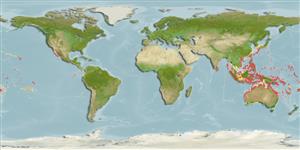>
Gobiiformes (Gobies) >
Gobiidae (Gobies) > Gobiinae
Etymology: Valenciennea: From Achille Valenciennes 1794-1865; he worked with Duméril, Cuvier and Lacepède since 1815; malacologist, author of a "Histoire naturelle des poissons" (Ref. 45335).
More on authors: Lay & Bennett.
Environment: milieu / climate zone / depth range / distribution range
Sinh thái học
Biển Cùng sống ở rạn san hô; Mức độ sâu 2 - 30 m (Ref. 27115), usually ? - 6 m (Ref. 8527). Tropical; 22°C - 27°C (Ref. 27115)
Indo-West Pacific.
Bộ gần gũi / Khối lượng (Trọng lượng) / Age
Maturity: Lm ? range ? - ? cm
Max length : 18.0 cm SL con đực/không giới tính; (Ref. 48637)
Các tia vây lưng cứng (tổng cộng): 6 - 7; Các vây lưng mềm (tổng cộng): 12-13; Tia cứng vây hậu môn 1; Tia mềm vây hậu môn: 11 - 13. Characterized by pale grey body color, grading to white ventrally; presence of five, blue-edged bars extending ventrally to middle of side, each bar containing reddish brown to black blotch at bottom; blue bands; spots on head; pectoral fin base with a pair of pink stripes; dorsal fin with narrow pink bands and blue to reddish spots on second dorsal and caudal fins; without dorsal filamentous spines; rhomboid caudal fin, longer than head; length of caudal fin 2.7 in SL; longitudinal scale series 80-121; ctenoid body scales , becoming cycloid anteriorly below first or second dorsal spine; head or midline of nape without scales; side of nape with scales extending forward to above middle of operculum; usually scaled pectoral fin base in adult; partly or fully scaled prepelvic area of adult; depth of body 6.0-6.7 in SL (Ref. 90102).
Occurs in areas of fine sand and shallow lagoon reefs at depths less than 3 m, rarely at depths greater than 6 m. Adults usually in pairs, constructing burrows under rubble. Monogamous (Ref. 52884, 48637). Feeds on small invertebrates (e.g. copepods, amphipods, ostracods, nematodes, and foraminiferans) by sifting mouthfuls of sand.
Life cycle and mating behavior
Chín muồi sinh dục | Sự tái sinh sản | Đẻ trứng | Các trứng | Sự sinh sản | Ấu trùng
After spawning, a paired female constructs a mound on the burrow made up of dead coral fragments while the male watches over the eggs in the burrow (Ref. 85149). The mound promotes water-exchange in the burrow which helps the male in tending the eggs (Ref. 85149). The amount of female parental investment is displayed by the height of the constructed mound (Ref. 85149). Consequently, larger females build higher mounds which affects male mating preference (Ref. 85149). Monogamous mating is observed as both obligate and social (Ref. 52884).
Hoese, D.F. and H.K. Larson, 1994. Revision of the Indo-Pacific gobiid fish genus Valenciennea, with descriptions of seven new species. Indo-Pac. Fish. (23):71 p. (Ref. 8527)
IUCN Red List Status (Ref. 130435)
Threat to humans
Harmless
Human uses
Các nghề cá: buôn bán nhỏ; Bể nuôi cá: Tính thương mại
Thêm thông tin
Các tài liệu tham khảoNuôi trồng thủy sảnTổng quan nuôi trồng thủy sảnCác giốngDi truyềnElectrophoresesDi sảnCác bệnhChế biếnNutrientsMass conversion
Các công cụ
Special reports
Download XML
Các nguồn internet
Estimates based on models
Preferred temperature (Ref.
123201): 24.3 - 29.3, mean 28.5 °C (based on 2431 cells).
Phylogenetic diversity index (Ref.
82804): PD
50 = 0.5000 [Uniqueness, from 0.5 = low to 2.0 = high].
Bayesian length-weight: a=0.00661 (0.00363 - 0.01204), b=3.09 (2.94 - 3.24), in cm total length, based on LWR estimates for this species & (Sub)family-body (Ref.
93245).
Mức dinh dưỡng (Ref.
69278): 3.0 ±0.1 se; based on diet studies.
Thích nghi nhanh (Ref.
120179): Trung bình, thời gian nhân đôi của chủng quần tối thiểu là 1.4 - 4.4 năm (Preliminary K or Fecundity.).
Fishing Vulnerability (Ref.
59153): Low vulnerability (12 of 100).
Nutrients (Ref.
124155): Calcium = 90 [40, 161] mg/100g; Iron = 0.623 [0.325, 1.187] mg/100g; Protein = 17.9 [16.0, 19.6] %; Omega3 = 0.082 [0.037, 0.153] g/100g; Selenium = 26.9 [13.7, 56.3] μg/100g; VitaminA = 110 [28, 381] μg/100g; Zinc = 1.74 [1.15, 2.55] mg/100g (wet weight);
